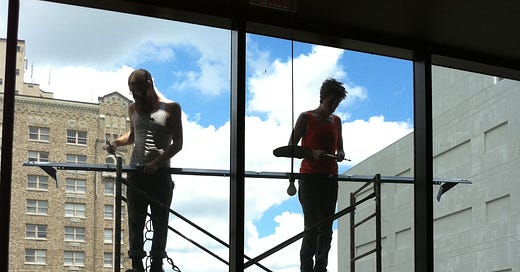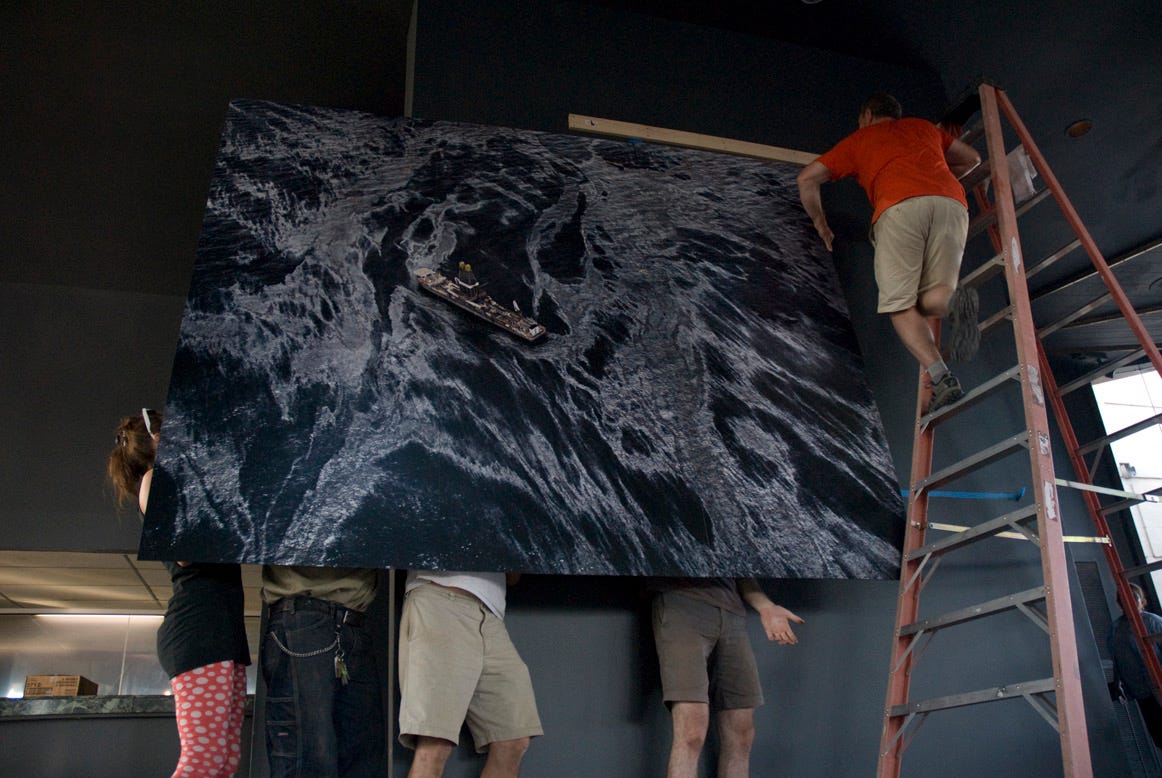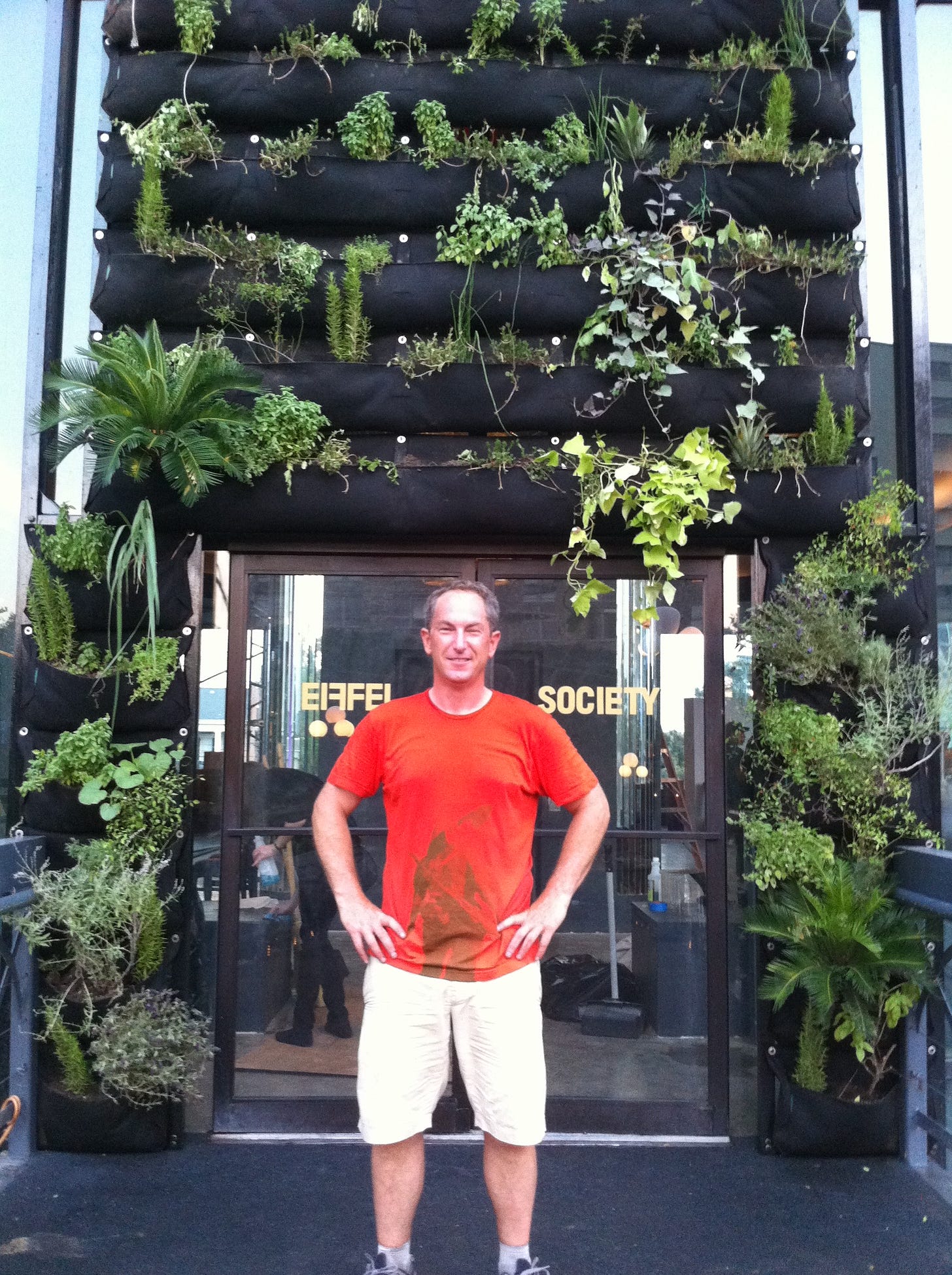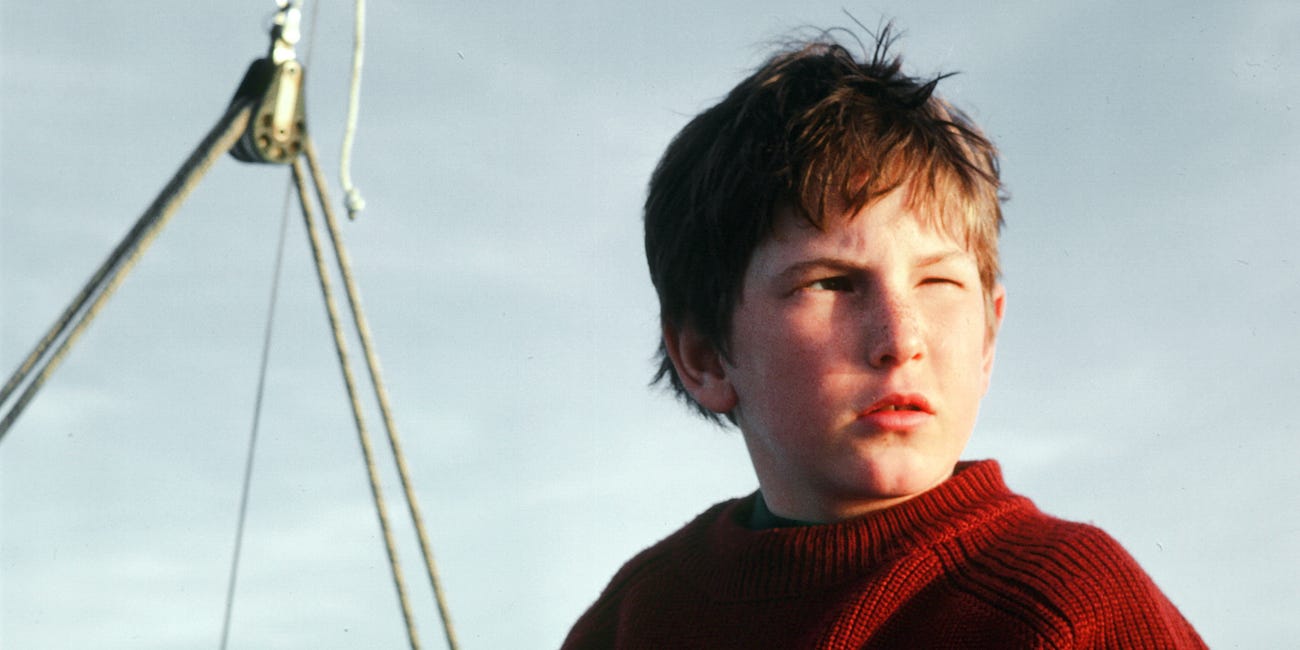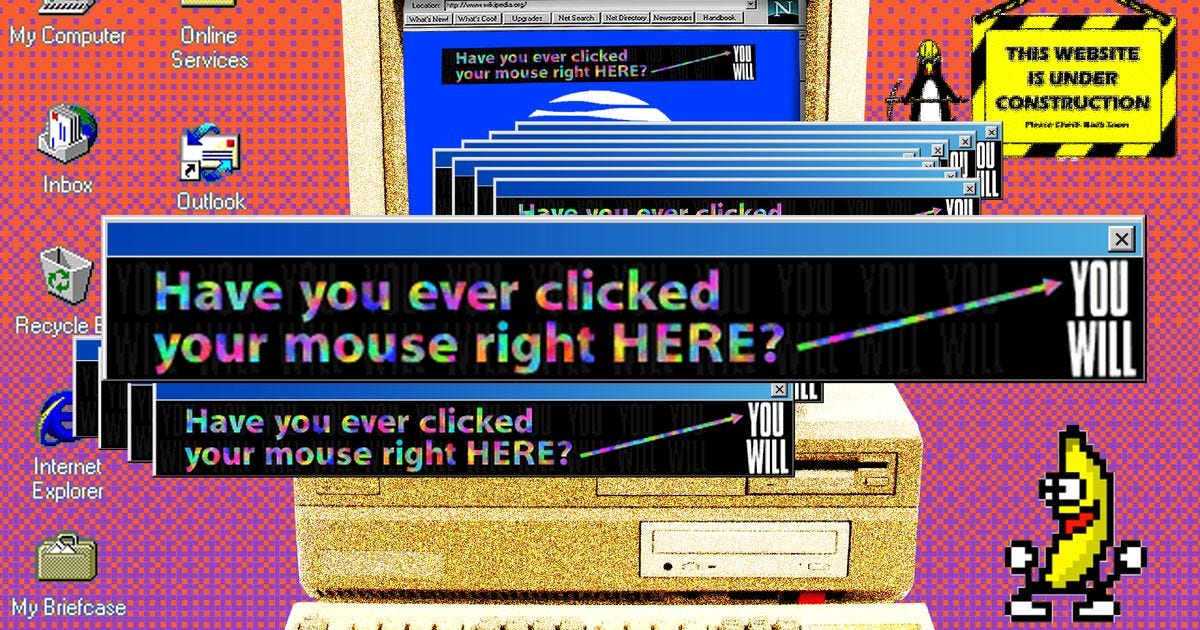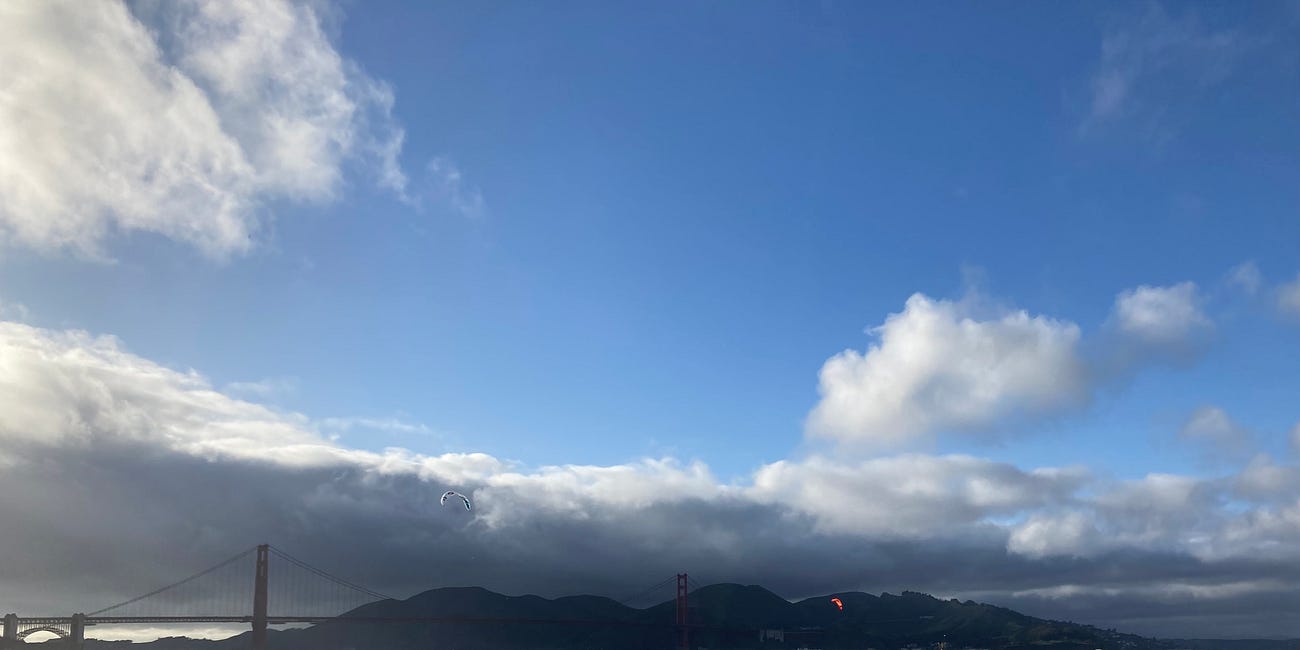Not all that long after crashing my car, I experienced another, very different sort of collision in my world as a new creative energy came to the fore—and as so often in the past, it was by way of another girlfriend. This time the result wasn’t a disaster but an epiphany, followed by a life-changing success.
Kat was an artist that I’d met in a roundabout way through my conference business; we were planning to hold one of our events in New Orleans, and she had set up shop there in the wake of Hurricane Katrina, buying several ruined properties on a shot-out block in the Lower Eighth, and heading up a loose collective of artists and musicians whose mission—described with a mischievous wink—was “life is art.” A platinum blonde with an otherworldly look, space-blue eyes and unshakable poise, Kat had grown up at the cultural intersection of California aerospace skunkworks and early psychedelic intelligentsia, and we developed a relationship as we shuttled between San Francisco, New Orleans, New York and Europe that was romantic at times, but first of all, creative and economic.
I’d once been called a snob for admitting that I wanted more artists as friends; the fact was and still is that I admire the freely creative more than anything else, and Kat was a force of that kind of nature, born free and actually living a life that was so far from what I knew that I couldn’t really begin to imagine it—and so, it’s true that that was a big part of what attracted me to her world. It’s also true that, as she saw things, the entire purpose of money was for the making of art, and so she was unabashed in her pursuit and consumption of funding, however it might be secured—and her personal relationships often had a financial component, as did our own. While I was certainly familiar with the traditional masculine role of covering dinner, plane tickets, and even the rent, it was a bit of a leap for me to digest her requests for five- and ten-thousand dollar checks to back her creative projects.
I eventually saw her logic. Her argument was: you seem to have extra money, I can use it, so why not slide some my way? She didn’t hesitate to play the coquette in making her pitch, and I did write some checks, which, along with the fact that we were intimate with one another, and had also in certain respects become business partners, made for a complicated relationship indeed.
Kat was not just some gallery girl. She’d trained as an architect, and had real skills in getting things done, as well as an incredibly powerful charisma that always attracted volunteers of all sorts. Men and women both were constantly turning up at her door ready to do her bidding, and often with no expectation of pay. They just wanted to be around her—just as I did, and I suspect that I wasn’t the only one paying for privilege, one way or another. I suppose there was a sliding scale.
She’d made a bit of a name for herself around town post-Katrina, enough to open doors beyond the art-school world that came through to gawk at her ramshackle installations. When word got around that a group of young club promoters were aiming to open a sort of members-only lounge on St. Charles Avenue in a unlikely historic structure that had been reconstructed from parts salvaged from the Eiffel Tower in Paris, she angled hard for the gig—and, after a few meetings during which we cooked up an entirely imaginary budget and agreed to an equally unlikely contract—she landed it.
Her clients thought they were getting an art director, project manager, and draftsperson all rolled into one; she giggled and assured them of her chops—but she saw the whole thing as a performance. They had a budget, a schedule, and the full intention of opening a banging new venue. To her, it was yet another opportunity to transform their geld into… pretty much whatever came to her pretty little mind.
They handed over their blueprints, and she pulled out her little black book. A couple of weeks later, a pack of her most talented acolytes descended in response to the lure of paid work—not that she’d necessarily promised anything specific. As more and more of these wild-haired, powerful young women arrived, it became clear that the brick shell of a bakery where she lived was too bare, and too edgy, to accommodate them all. The solution, of course, was to move the whole lot of them to the job site!
It’s fair to say that the clients and investors were at least momentarily taken aback to find her living there, but this is the kind of thing that can happen nowhere else but New Orleans—especially in the years following the storm. And after all, how else was this ragtag team to discern the subtle energies of the place well enough to determine what needed doing?
Visiting between my own business trips for my ongoing series of conferences, I arrived again at one point after they had been occupying the place for some weeks. Occupying a quarter of a city block, the building is an octagonal structure of steel and glass forming a single interior space more than a hundred feet across and thirty feet high, all suspended fifteen feet or so above the ground. It looked strange sitting among the gingerbreaded antebellum mansions of the surrounding Garden district. Like the original Tower in Paris, it might have seemed futuristic at the time of its original construction in the late 1800’s, but at this point the building had the appearance of an ungainly iron-age spaceship that had suffered a mechanical failure on the launch pad and now sat idle. The paint was peeling, and rust streaked down the pilings into the sticky, disused asphalt parking lot below.
Kat and six or seven of her friends were sleeping and working there, sharing a single rundown bathroom and a heavily-used industrial kitchen. There were no bathing facilities, and the AC came and went with the summer storms. I pitched in however I could, bringing in cases of wine, cooking big, cheap dinners out of whatever was on hand, and, after weeks of makeshift showers with a garden hose in the parking lot, digging an old bathtub out of Kat’s garden and plumbing it, at her request, smack in the middle of the space that we all shared. The women studied Jung’s Red Book, organized photo shoots and hammered away at various projects what were curious and sometimes beautiful, but also mostly of no practical use in the context of a functioning restaurant.
The heat did its best to steam us all into submission and sloth, but we weren’t slacking. We we working hard to finish something that could at least be claimed to meet the terms of the contact that Kat had signed—and, it was all part of the performance, which they all took even more seriously.
One morning as we rushed to meet the deadline for an early-opening party, the atmosphere was crackling with the accumulated tension of all of us living there together in a pile. By ten o’clock the air inside what was effectively a giant Victorian hothouse had already crossed a threshold that we knew well. We’d be sweating until well after dark, and the space was a clamor of visiting workers, sawdust, the hum and chatter of power tools, and a dozen simultaneous conversations, the angled panes reflecting blinding arcs of sunlight in every direction. I was weary from the night before, the heat—and also of my peculiar status.
Kat was the queen of the whole show, which gave me a certain cachet as her man, but I was alone amidst a coven of whispering, sensual women who knew that I was partially underwriting their experiment. Did that grant me more power, or less? To me, it felt like less, as if I was the client, as opposed to the patron.
What’s more, by that point, Kat and I weren’t having sex. We were still sharing a bed, but the relationship had shifted. I was there to support her project, but also because I knew that I was learning something important. My position had become a combination of favored concubine, eunuch assistant, and student assistant. It was emasculating, unsatisfying and unsustainable, but it was also a fascinating, dynamic and very unique environment, and I knew that it was a moment for me that wouldn’t be repeated.
Later that morning, as the sun neared its blazing noontime zenith, I searched the space for somewhere quiet and cool to rest. I found refuge in what one of her collaborators called the Superconductor, described as an “orgone accumulator” in the form of a large tent framed in chicken wire and covered in a thousand bolts of florid silk. I took the pseudo-science of this so-called orgone energy as yet another conceptual reference; either way, it made a perfect spot for a nap.
I ducked through one of the openings in the fabric and crawled deep inside, finding myself in a womb-like cavern suffused with a soft glow filtering through the layers of colorful cloth. The insistent din of activity receded as I stretched out, cocooned, and fell quickly into dreaming.
As the only man chosen—or who had dared—to join their all-female tribe, I had been keenly aware of the sexual energy in the room, day after day—and that all of that energy was subsumed into the creative vortex. Art took precedence over everything. Perhaps I was oblivious, but it seemed to me that sex was everywhere but the physical act; instead, erotic energy was bunkered by night and then burned as psychosexual fuel in the daytime—and now, I was asleep inside a homebuilt orgasmatron.
I lay on my back, suffused in a honeyed warmth that I hadn’t felt in weeks. No wonder my unconscious mind drifted from its usual dreamtime patterns of hurried pursuit and attempts at escape to an expansive vision of orgiastic pleasure, populated by the same group of comely witches that I was living and working with.
After an hour, I woke with a snap—fully awake, wholly refreshed, and with no tension whatsoever in my body. Everything had drained away—except for a curious phrase which scrolled clearly across my interior visual field in the last moments before I rose: “OPS is sexy.”
I couldn’t help but laugh. I’d followed yet another woman—and for once, not on an alcohol and sex-fueled bender but in response to my creative intuition—this time to New Orleans, becoming part of her brilliantly zany, Warholian ’factory,’ and then finally climbed right up into the birthing chamber itself, where all of the repressed sexual energy had been alchemized, reduced, and spat out again—as nothing more or less than the word “sex” itself.
Sex was in the air, but nobody was having sex. The whole thing was already a sort of cosmic joke, all the more for the fact that nobody but me would have understood what “OPS” was, and that of course it was the farthest thing from “sexy,” or even just something other than unknown and forgettable.
OPS was the name I’d come up with for a new event that I was planning to introduce as an adjunct to my original AdMonsters conferences, in an effort for further expand my business. Short for “operations,” or really, online advertising operations, I’m sure that this incredibly obscure niche within the world of digital media—or, for that matter, any conference at all—had ever occurred to anyone as anything like alluring.
Perhaps though, as my dream was suggesting, the opposite could somehow also be true.
The fact was that at the time, almost every web site from the New York Times to Google depended on advertising for almost all of their income, and because of the unbelievably byzantine, multi-layered software systems that were required to run these sites, no money could be made without the constant efforts of these almost always anonymous ops teams.
That was true—but the truth is rarely enough to get anyone excited. After ten years of serving this core audience as a tribe unto themselves, I’d already determined that it was time to bring them out into the light, but I hadn’t been clear on how to transform the public perception of “ops.“
The orgone tent had just dreamed me up the perfect solution. Just by invoking the word, it became clear that these nerds in the basement could be seen as pretty damn sexy after all. In actuality, they were not just central but essential, and without them the machinery of the entire online media landscape would grind to a halt. As ridiculous as it sounded, “OPS” was sexy—and in part, just because I had dreamed it.
Later that summer, I hired one of Kat’s entourage to fabricate a mirrored podium with a dramatically glowing bright-blue neon OPS sign to on stage, and kicked off the first of these new conferences with an awkward but heartfelt skit explaining what had come to me in my dream. It may have been laughable—but you know what, it worked. The new conference was a success—and, just as importantly, the idea that their work was sexier than anyone had thought took off, and the roles of not just ad ops, but all kinds of “ops” are now seen as a crucial part of the landscape of how digital companies do their business.
Those words had a real impact. I’d conjured up my own little spell—and although in the large scheme of things, the idea that this ops thing is anything like cool is still a hard sell, it’s also true that ten years down the road, some people in that industry were still using the phrase “ops is sexy”—and along with what it did to open the doors on that little world, that simple message did a lot to point me and my business in the direction of a truly life-changing milestone that I achieved not all that long afterwards.
That momentary revelation was concrete evidence that my own creative energy was coming to the surface, into my daily life, and even into my own business. Much like the attendees at my conferences, I began to see that the work that I’d been so alienated from for so long could exciting, stimulating, worth putting my heart into, and even something to be proud of.
An orgone-infused daydream helped to make my work alive for me again—and it helped to make me alive again. Something really had rubbed off, and I would never be the same because of it.
Thanks for reading, and for being part of this journey.
This is part of AN ORDINARY DISASTER, one man's proof that despite what may seem like our inability to hear it, and all of our attempts to avoid it, we can all learn to listen to ourselves, and to act upon the inner voice of our self, our sanity and our soul.
Further reading
Here’s the table on contents for the memoir. You might also enjoy some of my other work, such as:
The Man Pays
My friend Meredith always had a knack for finding places where rent was optional. I was on one of my early trips to New York City, summer of ’97 I think, staying with her and another friend from college in a fourth-floor walkup on Second Ave near 11th—and the owner had just disappeared. Not quite a squat, like the occupied warehouses that I knew of in S…
Chapter 12 — Early days in the advertising-industrial complex, why nobody wants to pay for writing online, and why most conferences are so terrible.
When I look back at those last years of the nineties, it feels like a blur, and a binge. I was working the back half of what had unexpectedly become a first career in what had already started to be call…
or any of the other essays that you can find here:
Eighteen essays about addiction, masculinity, creativity, and intuition
I recently divided my stack into sections—memoir, essays, mediations, and perhaps soon more—and in doing so I was reminded that I’ve put out no fewer than eighteen long form essays so far here, on topics ranging across anxiety, fitness, creativity, sobriety, self-discipline, purpose, love, adventure, sciatica, pain, AI, intuition, the collective unconsc…
Please share, comment, restack, recommend, and click the little ♡ heart right there 👇🏻 if you dig this piece. I’d love to hear from you!

